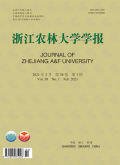浙江农林大学学报2024,Vol.41Issue(5):898-908,11.DOI:10.11833/j.issn.2095-0756.20240156
浙江省种植业碳排放时空演变规律及驱动因素分析
Spatiotemporal evolution law and driving factors of carbon emissions in planting industry in Zhejiang Province
摘要
Abstract
[Objective]The aim is to explore the spatiotemporal evolution law and influencing factors of carbon emissions in planting industry in Zhejiang Province,in order to develop a carbon sequestration and emission reduction plan and promote low-carbon and green transformation of planting industry in Zhejiang Province.[Method]Based on the energy input data of planting industry in Zhejiang Province,the carbon emission coefficient method was used to assess the spatiotemporal evolution of carbon emissions of planting industry in Zhejiang Province from 2006 to 2021.Combined with Logarithmic Mean Weighted Divisia Index(LMDI),the driving factors of carbon emissions changes in planting industry were analyzed,and the grey prediction model was used to predict the carbon emissions of planting industry from 2022 to 2040.[Result](1)From 2006 to 2021,the overall carbon emissions from planting industry in Zhejiang Province showed an upward trend followed by a downward trend,with an annual variation rate of-1.80%,and a total cumulative carbon emission of 129 million tons.Between 2006 and 2012,carbon emissions slowly increased and then sharply decreased after reaching a peak in 2012,with an average annual decline of 2.94%.(2)The carbon emissions from planting industry in Zhejiang Province showed a distribution pattern of high in the central region and low in the north and south.Hangzhou,Jinhua and Taizhou in the central region were the main carbon emitting regions,accounting for 39.86%of the province's carbon emissions.(3)The improvement of planting industry efficiency and the optimization of regional industrial structure played a promoting role in carbon reduction,and the improvement of economic development level,the increase of population size,and the optimization of agricultural production structure were the driving factors that caused the increase in carbon emissions,among which the level of economic development was the dominant factor affecting the changes in carbon emissions,accounting for 41.58%of the total carbon emissions change.(4)The grey prediction model prediction results showed that the carbon emissions from planting industry in Zhejiang Province would continue to decline from 2022 to 2040,and the carbon emissions in 2040 would decrease to 37.20%of those in 2021.Among them,Hangzhou,Jiaxing,Shaoxing and Jinhua would have the largest decline.[Conclusion]Planting industry in Zhejiang Province has achieved carbon peak.To ensure a continuous decline in carbon emissions in the future,we should focus on optimizing agricultural production technology and adjusting industrial structure,applying chemical fertilizers rationally,improving planting efficiency,reducing energy consumption,and speeding up modernization of green agriculture,so as to accelerate the achievement of carbon neutrality goal.[Ch,4 fig.2 tab.37 ref.]关键词
种植业/碳排放/时空变化/驱动因素/碳排放预测Key words
planting industry/carbon emission/spatiotemporal change/driving factors/carbon emission projection分类
环境科学引用本文复制引用
李文寒,柳飞扬,张梦,顾蕾,周国模..浙江省种植业碳排放时空演变规律及驱动因素分析[J].浙江农林大学学报,2024,41(5):898-908,11.基金项目
浙江省科技厅"尖兵"研发攻关计划项目(2022C03039) (2022C03039)

